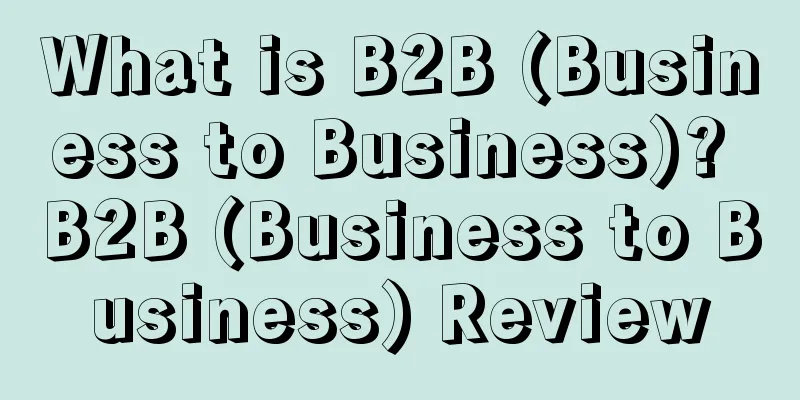What is B2B (Business to Business)? B2B (Business to Business) Review

|
B2B (Business to Business) refers to a business model in which enterprises exchange and transfer data and information and conduct transactions through a dedicated network or the Internet. Some people also write it as BtoB, which closely integrates the enterprise's intranet and the company's products and services with customers through B2B websites or mobile clients, and provides customers with better services through the rapid response of the network, thereby promoting the business development of the enterprise. Definition of terms B2B refers to the process in which both the supply and demand sides of e-commerce transactions are merchants (or enterprises, companies), and they use Internet technology or various business network platforms to complete business transactions. E-commerce is a specific and main form of modern B2B marketing. Contains three elements: 1. Buying and selling: B2B websites or mobile platforms provide consumers with high-quality and low-priced goods, which attracts consumers to buy and encourages more merchants to join. 2. Cooperation: Establishing a cooperative relationship with logistics companies to provide ultimate protection for consumers' purchasing behavior is one of the hard conditions of the B2B platform. 3. Service: Logistics mainly provides purchasing services to consumers, thereby realizing another transaction. B2B Model Vertical Mode Directindustry Vertical B2B is a manufacturing or business-oriented vertical B2B. It can be divided into two directions, namely upstream and downstream. Manufacturers or commercial retailers can form a supply relationship with upstream suppliers; manufacturers can form a sales relationship with downstream distributors. Simply put, B2B websites under this model are similar to online stores. This type of website is actually a corporate website, which is a virtual store opened directly on the Internet by the company. Through such a website, you can vigorously promote your products, use faster and more comprehensive means to let more customers know about your products, and promote transactions. Or it can also be a website opened by merchants. These merchants promote their own products on their own websites, and the purpose is to promote and expand commercial transactions in a more intuitive and convenient way. Comprehensive Mode B2B for the intermediate transaction market. This transaction model is horizontal B2B, which brings similar transaction processes in various industries together in one place, providing a transaction opportunity for the purchasers and suppliers of enterprises. This type of website is neither an enterprise that owns products nor a merchant that operates goods. It only provides a platform to bring together sellers and buyers online. Buyers can find relevant information about sellers and sales goods on its website. Self-built mode The self-built B2B model of industry leaders is that large industry leaders build industry-specific e-commerce platforms with their own product supply chains as the core based on their own information construction level. Industry leaders connect the entire industry chain through their own e-commerce platforms, and upstream and downstream companies in the supply chain realize information, communication, and transactions through the platform. However, this type of e-commerce platform is too closed and lacks deep integration of the industry chain. Association Mode In order to improve the breadth and accuracy of information on e-commerce transaction platforms, the industry has established a cross-industry e-commerce platform by integrating the comprehensive B2B model and the vertical B2B model. The Third Plenary Session of the 18th CPC Central Committee clearly stated that the market plays a decisive role in resource allocation, thus raising the status of the market system, market mechanism, and market economy in economic and social development to the basic institutional level. Industry B2B e-commerce platforms are emerging. Yiyuntong, a consulting agency that has long been engaged in professional market e-commerce services, has listed some issues under the new situation for us. For example, what is the relationship between industry B2B and the evolution and growth of the market economy? What kind of industrial ecological relationship is there between developing and improving the market system, industry B2B, modern logistics, exhibition and trade economy, and international procurement? B2B Process General process The first step is that when a business customer places an order with a seller, he or she must first issue a "user order", which should include a series of product-related issues such as product name, quantity, etc. The second step is that after the seller receives the "user order", he inquires about the product status from the supplier according to the requirements of the "user order" and issues an "order inquiry". The third step is that after receiving and reviewing the "order inquiry", the supplier returns the answer to the "order inquiry" to the seller, which basically includes whether there are goods. The fourth step is that after confirming that the supplier can meet the commercial customer's "user order" requirements, the seller sends a "transport inquiry" to the transporter regarding the transportation of the goods. Step 5: After receiving the "transportation inquiry", the transporter returns the answer to the transport inquiry to the seller, such as whether it is able to complete the transportation, and the requirements for the date, route, method, etc. of the transportation. Step 6. After confirming that there are no problems with transportation, the seller will immediately give the commercial customer a satisfactory response to the "user order", and at the same time issue a "shipping notice" to the supplier and notify the transporter for transportation. In the seventh step, the transporter starts to ship the goods after receiving the "transportation notice". Then the commercial customer sends a "payment notice" to the payment gateway. The payment gateway and the bank settle the bills, etc. In the eighth step, the payment gateway sends a "transfer notification" to the seller indicating the successful transaction. Manufacturing Process The first step is to receive customer orders, parse EDI standard data EDI ANSI - 850 or EDIFACT - ORDERS, save the necessary order data, and store it in the database; The second step is to upload the purchase order (PO) information to the ERP system. The ERP system creates a sales order and then feeds the relevant information back to the ERP system; Step 3: The B2B system returns the order information to the customer, EDI ANSI - 855 or EDIFACT - ORDRSP; In the fourth step, the ERP system creates a production order, and the production site management system (SFC) downloads the production order, arranges production, and generates relevant product data. Step 5: B2B obtains the IDOC information transmitted by ERP and stores it in B2B DB. According to the existing ShIPID, it obtains the cargo data, packaging list, etc. from SFC DB; Step 6: B2B generates a ShipNotice, EDI ANSI - 856 or EDIFACT - DESADV, and sends it to the customer; Step 7: Receive customer confirmation of the waybill, EDI ANSI - 824 or EDIFACT; Step 8. Send the invoice to the customer, EDI ANSI - 810 or EDIFACT - INVOIC. cost 1. Technology Cost B2B technology costs include software and hardware costs, learning costs, and maintenance costs. E-commerce is the product of the combination of various technologies. Expensive investment, complex management, and high maintenance costs make some companies that lack systems, technologies, and talents reluctant to start. 2. Security costs In any case, transaction security is always the primary issue that people are concerned about. How to ensure the fairness and security of transactions online, the authenticity of the identities of both parties to the transaction, the integrity of the transmitted information and the non-repudiation of transactions has become the key to promoting e-commerce. 3. Logistics costs The most difficult problem to solve in e-commerce is logistics and distribution. Logistics and distribution is the most important and final link in e-commerce, the goal and core of e-commerce, and an important measure of the success of e-commerce. 4. Customer Cost The customer cost of e-commerce refers to the total cost spent by customers on Internet access, consultation, payment, and finally the arrival of goods during online transactions. This is a service that is completely dependent on the Internet. As soon as consumers start to enjoy such services, they have to bear a minimum cost of several yuan per hour, not including the cost of purchasing corresponding hardware equipment and learning how to use it. Optimization Problem Comprehensive Questions The structure of a B2B website looks simple, with major columns such as supply information, purchase information, product library, and enterprise library, as well as classification of different industries and product categories under each column, and the corresponding information is published in the corresponding classification. But in fact, the classification method of a B2B website is crucial to the overall optimization of the website, because an unreasonable classification directory will cause users to have difficulty in obtaining website information, search engines to ignore secondary columns and information in secondary columns, and the website's PR value to be low. Collection issues With the increase in the amount of supply and demand information released, a large amount of newly released information is constantly updated, but a lot of new information has been rolled down to the multi-level directory before it can be included in the search engine. Due to the unreasonable design of the website structure, even if all web pages are converted into static web pages, it is still possible that the information cannot be included in the search engine. Dynamic web page issues Leading websites have long been optimized and transformed to achieve static processing of all information, but as B2B websites have developed to this day, there are still a large number of websites that use fully dynamic web page technology, and even the main columns and secondary columns are dynamically generated. Such dynamic websites can no longer gain any advantage in the search engine's natural retrieval results. Even if the web pages are included in the search engine, it is difficult to gain any advantage over other static web pages with similar content. As a result, the number of visits brought by the search engine's natural retrieval is getting smaller and smaller. Relevance issues In websites where the content is generally edited by website maintainers, the design of web page titles and the relevance of web page titles to web page content can be well controlled. However, in B2B industry websites where users publish information on their own, the problems of unprofessional web page title design and low relevance to web page content are more prominent. The consequence is that not only do the supply and demand information content web pages have no competitive advantage in search engines, but they may even affect the performance of the entire website. This is described in "Analysis of low-quality web pages in search engine retrieval results and their causes". There are many various problems in B2B e-commerce website optimization. In addition to the basic website elements that are not taken into account in website optimization, there are also various problems caused by improper operations when B2B website technicians are groping for website search engine optimization. Many problems have accumulated over time and have become difficult and complicated diseases. Not only have they failed to achieve the purpose of website optimization, but they have caused more problems for the website. Business Model However, not all successful B2B websites in China are online transaction models, especially B2B industry websites. Many of them do not conduct online transactions, but are more focused on online marketing and brand awareness based on transactions. Based on the analysis and research of the current successful B2B industry websites, 10 B2B industry website business models and corresponding combination plans are summarized. 1. B2B industry websites that provide product supply and procurement information services as their main business model This type of website should establish a product database with complete classification, multiple product varieties, complete product parameters, and detailed product introductions. In particular, it should pay attention to the quality of product information and continuously update it. More recent, most authentic, and most accurate product information should be released in a timely manner to comprehensively improve the purchasing experience and attract more buyers and suppliers to post information and browse and search for information on the website. It mainly charges membership fees, advertising fees, bidding ranking fees, and basic network marketing service fees from small and medium-sized suppliers. 2. B2B industry websites that provide franchise agency services as their main business model Companies whose products are directly sold to consumers usually look for franchisees and agents to sell their products. The business model of such companies is usually design + sales or design + production + sales. Such websites are designed with functions and pages based on the needs of brand companies and distributors. For example, clothing websites should provide dynamic, image galleries, fashion trends and other industry information, comprehensively collect clothing brand information, and establish a large and accurate franchisee and agent database. The profit model of such websites is mainly to collect advertising fees and membership fees from brand companies, especially advertising fees, which will account for the majority of the proportion. 3. B2B industry websites that provide production and outsourcing information services as their main business model Industries that mainly provide production outsourcing services have the following characteristics: The profit model of such B2B industry websites is to collect money from factories, find better orders for them, provide on-site factory visits and take photos, and ensure that the production strength information of the main factories promoted for a fee is true, rich and accurate. 4. B2B industry websites that provide small-amount online wholesale transaction services as their main business model To operate this type of website, you need to have a very good understanding of the needs of retailers, establish a sound online integrity system, a perfect payment system, and have a rich variety of products and detailed information. Currently, comprehensive and large-industry websites are more likely to succeed. 5. B2B industry websites that provide online commodity trading services as their main business model The profit model of this type of website is mainly to collect transaction commissions, provide industry analysis reports, hold industry conferences, etc. The integrity review of buyers and sellers, payment security, logistics speed, etc. can be solved by using third-party partners. To enter this type of website, you must first choose a good industry. Secondly, the threshold is relatively high, and you can develop in some emerging markets. 6. B2B industry websites whose main business model is to provide competitive intelligence services to enterprises The core management of the team must have industry background, otherwise it will be difficult to find information sources and large companies will be unwilling to buy. It is suitable for analysts who have resigned from such websites, as well as people with certain industry backgrounds in industry associations, chambers of commerce, traders, etc. The market demand is relatively large, and many industries allow several websites to survive. Profit models include: membership fees, report sales, consulting, journals, conferences, advertising fees, etc. 7. B2B industry websites with business opportunity channels + technical community services as their main business model The profit model of the technical community includes: recruitment and job search services, technical conference services, training school advertising, software advertising services, equipment advertising, etc. More importantly, it is to increase user stickiness for the business opportunity column. When operating, it is necessary to serve technical novices and technical experts well, so that experts can show themselves and their products in the community and get spiritual satisfaction, and let novices learn knowledge here and ask questions to technical experts. Only in this way can the technical community have internal driving force and achieve long-term and continuous development. Generally, it includes: Q&A, blogs, photo galleries, recruitment and job search, downloads, personal space, Weibo, conferences and other columns. 8. B2B industry website services as the main business model We must pay attention to controlling costs. Don't print too much at the beginning. At the same time, we use more offline channels to promote. Generally, we distribute it for free at exhibitions across the country, and distribute it to target readers and advertisers for free through express delivery. We find customers who are more receptive to paper media, and the distribution must be accurate. The profit model is: the cover, front color page advertising, inserts, headers, footers, bookmarks, and advertising spaces on the right side of the general catalog can all be given to customers who purchase the front color page and cover and back cover, including interviews, soft articles and other promotional services, which can also improve the credibility of the website. 9. B2B industry website exhibitions and conference services as the main business model Generally, when such websites hold meetings, they need to establish good relationships with industry executives, including associations, local governments, universities, and research institutes. When holding meetings, they need their support so that the meetings can become more high-end and more corporate executives can attend. They can be operated in conjunction with B2B industry communities, attracting the attention of industry users through the community, and then bringing these users together for meetings to solve some problems. 10. The main business model is B2B industry website + domain name space + website construction + search engine optimization services To build this type of website well, the team must have experience in enterprise website construction and operation, industry website operation, and enterprise website search engine optimization ranking. Some companies with backgrounds in enterprise website construction and enterprise network marketing and promotion services choose this model to build B2B industry websites, and the profit model is relatively mature. However, many companies lack the background in B2B industry website operation, and as a result, the B2B industry website has become a decoration and has not played a substantial promotion role. Companies that successfully operate B2B industry websites are more likely to be successful if they choose this business model. PPC In order to promote product sales, companies hope to rank higher in information searches on B2B websites. On the basis of ensuring the accuracy of information, the website will make corresponding adjustments to the ranking order based on different member fees. Value-added Services In addition to providing trade supply and demand information for enterprises, B2B websites usually provide some unique value-added services, including enterprise certification, independent domain name, industry data analysis reports, search engine optimization, etc. For example, spot certification is a special value-added service provided for the electronics industry, because electronic buyers usually pay more attention to inventory. In addition, the Google ranking promotion service for electronic models is a kind of search engine optimization. Offline Services Mainly include exhibitions, journals, seminars, etc. Through exhibitions, suppliers and buyers communicate face to face, and small and medium-sized enterprises generally prefer this method. Journals are mainly about industry news and other information, and advertisements can also be embedded in journals. Business Cooperation Including advertising alliances, government, industry associations, traditional media cooperation, etc. Advertising alliances are usually online advertising alliances, but in China, affiliate marketing is still in its infancy, and most websites are relatively unfamiliar with affiliate marketing. Development Development Status The frequent closure of Internet companies, the bursting of the Internet bubble, and the vigorous e-commerce fever have made B2B enterprises experience a bumpy journey of development, elimination, and recovery. Along the way, B2B has become increasingly mature, and with the support of China's suitable environment, strong support from the government and society, unique industry advantages and mature management experience, B2B has developed rapidly in all walks of life and defeated B2C in one fell swoop, occupying 95% of the e-commerce share. In 2006, it increased by 97% compared with 2005, with a total transaction volume of 1.28 trillion yuan. According to the "iResearch" research report, the transaction volume completed through B2B e-commerce in China in 2007 reached 2.1239 trillion yuan, an increase of 65.9% over the previous year. China's small and medium-sized enterprise e-commerce will enter a "blowout" development period. B2B was also rated as No. 1 among the top ten profit models in 2007. But under the shadow of the halo, there are many dark sides that deserve our attention. Such as the monopoly of comprehensive platforms, the stickiness of B2B, and the stagnation of B2B for small and medium-sized enterprises. 1. Single model Looking at the current domestic B2B field, there are two models: one is the industry vertical B2B e-commerce website, that is, to do in-depth and thorough research on an industry, such as China Chemical Network, Global Hardware Network, etc. Such websites are undoubtedly more authoritative and accurate in terms of professionalism. The other is the horizontal comprehensive B2B e-commerce website. Covering the entire industry, focusing on breadth, such as Alibaba, Global Sources, etc. ⑴ Industry comprehensive B2B model. This model is relatively mature and low-risk, but the model is single and outdated, including models that focus on "supply and demand business opportunity information services", "industry consulting services", "investment and franchise services", "project outsourcing services", "online services", and "technical community services". Maimai.com, Shanggelila, Hualian B2B online trading platform, Zhongqidongli "DaDaBa", China.com's "China Suppliers", Yixi.com and other websites are all in a state of hesitation. All this shows that B2B needs business model innovation. It is difficult to surpass peers by relying on a single outdated model. ⑵Industry vertical B2B model. Vertical website services and professional website services will become the focus of competition among various B2B companies and large enterprises because of their uniqueness, innovation and flexibility. It is also another new development direction of the future B2B market. Although enterprises in the vertical B2B model account for a small share of China's B2B market, it is a model favored by many venture capitalists, and several dark horses have emerged. 2. Too much pressure After experiencing the brief excitement of Sinochem.com’s listing, e-commerce has returned to hibernation. Except for a few websites such as Alibaba, Huicong, Sinochem, and Global Sources, most other websites have not been fortunate enough to receive social attention and media attention. Instead, they have stayed in the soil for several years like cicada larvae. The phenomenon of “big sticking to small” and the “Matthew effect” have emerged in the integrated platform. Several large websites have suffocated or “stillborn” small B2B websites. In the process of e-commerce application and development in China, enterprises play a very important role. However, among the domestic enterprises that have been online, there is a lack of detailed planning on how to carry out online marketing and business activities. Although most enterprises have been connected to the Internet, most of them have only opened homepages and email addresses online. Many website contents have not been updated for a long time, let alone using network resources to carry out business activities. 3. Fuzzy understanding Enterprises have a vague understanding of why they need B2B intermediary service websites. It will be a big problem to let unfamiliar buyers and sellers communicate, query and match each other on the Internet. There will be four problems between buyers and sellers: First, due to poor information communication, it will inevitably lead to asymmetry between production and demand, and the coexistence of commodity shortages and surpluses; second, due to the limited number of buyers corresponding to one seller, many buyers and sellers will form a multi-layer sales chain, thus generating many intermediate links, resulting in higher and higher sales costs; third, due to the limited choice of buyers and sellers, the buying and selling bidding is insufficient, which not only affects the transaction efficiency but also fails to create a fair market environment; fourth, due to poor information, the market response is slow, resulting in inventory backlogs and increased production costs. To solve the above four problems, it is necessary to establish a public information exchange and transaction platform. As one of the three major foreign trade e-commerce companies in China, Global Market Network has been committed to uniting 100,000 high-quality manufacturing companies in China to create a credible international trade platform. 4. Acting Blindly The actions are blind on how to effectively carry out B2B e-commerce. The common phenomenon is: ⑴ The content positioning of the corporate website is inaccurate, or the design is too simple, with only a homepage and e-mail address; or the company's website only pursues big and comprehensive information, and publishes information without distinguishing between the primary and secondary; or the company only pursues powerful website functions, attempting to be a "one-stop" website. ⑵ The business model is incorrect. There is a lack of fundamental understanding of where to attach the website to facilitate the development of the company's online business. It is believed that if there is a registered domain name, merchants will automatically come to the door through the Internet. Development Trend Global B2B e-commerce transactions have always been dominant, and have been growing rapidly since 2002. In 2007, the global B2B transaction volume reached 8.3 trillion US dollars, and in 2010 it reached 13 trillion US dollars, an increase of more than 50% over 2007. In 2007, China's B2B e-commerce transaction volume was 1.25 trillion yuan, and in 2010 it reached 3.8 trillion yuan, which shows how huge the B2B market is. 1. B2B will develop towards more segmented directions Small and medium-sized enterprises do not have strong financial support and are not capable of building B2B industry websites for the entire industry, but they can intervene in e-commerce websites for subdivided industries or regional e-commerce websites. For example, clothing and apparel, leather shoes, suits, men's clothing, women's clothing... Subdivided websites have certain development prospects. Generally speaking, no matter how detailed the industry the website is in, as long as there are more than 300 companies in the country that subdivide their products into company-leading products, there will be room for 1~2 B2B websites in these subdivided industries. 2. B2B regional websites will rise In fact, most of China's B2B/B2C trade is still concentrated in the same city and region. The reason why classified information websites such as 58.com and Ganji.com can be favored by VCs is that they have discovered the fact that the amount of transactions in the same city is huge. In the absence of a commercial credit system in China, most merchants are more willing to choose a closer purchase channel if they have a choice. This can better guarantee credit security, and secondly, it can better save logistics costs and increase profits. Therefore, it can be predicted that B2B regional websites will have a large development space. However, whether B2B regional websites can rise will also depend on the geographical advantages of website operators. 3. The rise of new B2B models Competition in the field of B2B e-commerce is becoming increasingly fierce, and a large number of B2B websites have fallen in the fierce competition. With their fall, new companies have won market recognition with new innovative models and have strong core competitiveness in the fiercely competitive market environment. Among them, the most representative new model is the B2B+M of the Central Asia Silicon Valley Network. ⑴B2B Original text: Business to Business refers to a market area, which is a marketing relationship between businesses. E-commerce is a specific and main manifestation of modern B2B marketing. It closely integrates the enterprise intranet with customers through B2B websites, and provides customers with better services through the rapid response of the network, thereby promoting the business development of the enterprise. ⑵M It is the abbreviation of MALL. B2B+M is a new business model that combines the online e-commerce platform represented by the Central Asia Silicon Valley Network with the physical mall based on the Central Asia Electronics Expo Center. B2B+M not only breaks the limitation of the radiation power of the physical mall, but also effectively makes up for the lack of integrity that is common in general B2B websites. 4. Industry B2B websites will play an industry service role in more links The credit and strength evaluation system for suppliers and buyers has been further improved and innovated. As the industry B2B portal website gradually penetrates the industry, the credit and strength of industry enterprises have become more transparent. Buyers have more opportunities to choose more of the most suitable suppliers. Many offline services will go deep into the company, such as: one-on-one training services, on-site evaluation, factory inspection, market research, talent recruitment, industry software services, etc. will be more widely used. |
<<: What is MobiKwik? MobiKwik Review
>>: What is Extremerebate? Extremerebate Review
Recommend
The gap between Amazon and Walmart continues to widen? Q3 retail business comparison
It is learned that Pymnts recently released the re...
Banned for exceeding shipping limits? FBA goods not being put on shelves and even lost? !
On July 13, Amazon changed the minimum IPI thresho...
What is Keepa? Keepa Review
Keepa is a free Amazon price tracking tool that sa...
Novice sellers-the goods are on the road, the advertisement must be opened well--3 steps to teach you how to open an advertisement
This issue 1. Amazon Advertising helps new produc...
What is Chollometro? Chollometro Review
Chollometro is a Spanish promotional website where...
The company's commission system changes every year, and I am increasingly eager to quit. Is there anyone looking for an operations job who can tell me what the market is like outside right now?
Anonymous user My C position I joined my current c...
Online retail sales in the U.S. during the holiday season increased by 6.7% year-on-year, outperforming in-store sales
It is learned that on December 26, according to fo...
What is Prestozon? Prestozon Review
Prestozon is an Amazon PPC management service that...
Amazon is the biggest winner of Cyber Week! 34.6% of American consumers shop on Amazon!
It is learned that according to a research survey ...
Wayfair lost $378 million in the second quarter! The number of active users has dropped significantly!
<span data-docs-delta="[[20,"获悉,近日美国家居电商Wa...
More than 360,000 children's toys have been recalled due to choking risks! Available on Amazon and other platforms
It is learned that on August 29, the U.S. Consumer...
What is ePacket? ePacket Review
ePacket is an economical international express ser...
What is BigYouzi? BigYouzi Review
BigYouzi is committed to helping sellers solve the...
Amazon lost a trillion dollars! Is there any other way to get keywords on the homepage?
According to foreign media reports, Amazon's s...
What is Manual Targeting? Manual Targeting Review
Manual Targeting is Amazon’s manual advertising. I...









